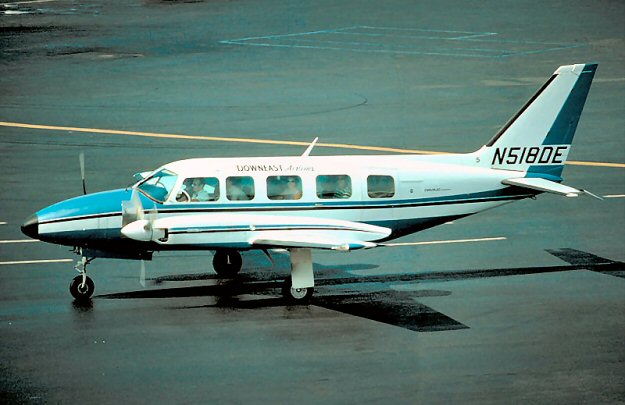Downeast Airlines Piper PA-31 Navajo
N518DE
(c/n

Downeast
Airlines was a Third Level commuter
carrier founded by Robert Stenger at Knox County
Airport
in Rockland, Maine in 1960. It began as an FBO and charter outfit
under the
name Mid-Coast
Airways .
In 1968 when Northeast was being merged into
Delta, the the latter airline (the buyer) applied
to
the CAB be allowed to discontinue the Boston to Rockland route which
NEA had been flying for
years.
Stenger applied for, and was qualified as, a Part 135 commuter airline
to continue this service
and began
scheduled operations, taking over the route from NEA/Delta. At
that time the
airline changed
its name to
"Downeast", a local term used to describe
that area from Rockland
south to Portland, Maine.
At the
time the company operated two Piper Aztecs, which were quickly
augmented with 4 Piper Navajos,
one of the
which is seen above in this image by Tom Hildreth at
Boston's Logan Airport
in July 1975.
In 1980 Stenger sold the Boston
to Rockland route to Bar Harbor Airlines, but
continued his air-taxi/
charter
business until 2007 when it was sold to Rockland Airport Partners, LLC
(dba Maine Atlantic
Aviation., .
Footnote:
In
1978 Downeast purchased the DHC-6 Twin Otter N659MA from Air Illinois
and re-registered
it
N68DE On 30 May 1979 N68DE was operating Flight 46
from Boston to Rockland when it
crashed into a heavily wooded area about 1.2 mi south of the Knox
County Regional Airport at Rock-
land, ME on final approach. Only one passenger of the two crew
members and 16 passengers aboard
survived, and he was severely injured. The following is an
excerpt from the ATSB report which
investigated
the accident::
"... the probable cause of the accident was
the failure of the flight crew to arrest the aircraft's descent at
the
minimum descent altitude for the non precision approach, without the
runway environment in sight,
for
unknown reasons *.
Although the Safety Board was unable to determine conclusively the
reason(s)
for the
flight crew's deviation from standard instrument approach procedures,
it is believed that inordinate
management
pressures, the first officer's marginal instrument proficiency, the
captain's inadequate super-
vision
of the flight, inadequate crew training and procedures, and the
captain's chronic fatigue were all
factors in the
accident."
* In other words,
the airline's management style, which indicated that the pilot had to
get into the
airport
at all costs (to save expenses) or
else, was the true reason why the captain did not seek an
alternate airport (or even return to BOS). Twenty years on,
this crash is still cited when discussing
"bottom
line" versus safety in the airline industry.
